Miele K 12012 S-2, K 12020 S-1, K 12022 S-1, K 12010 S-2, K 12023 S-2 User Manual
...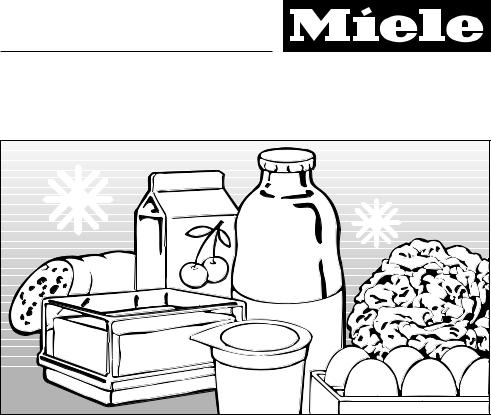
Operating and installation instructions
Refrigerator K 12010 S-2, K 12020 S-1, K 12023 S-2,
K 12012 S-2 K 12022 S-1 K 12024 S-2
To avoid the risk of accidents |
en - GB |
or damage to the appliance, it is |
|
essential to read these instructions |
|
before it is installed and used for the |
|
first time. |
M.-Nr. 09 552 430 |

Contents
Guide to the appliance . . . . . . . . . . . . . . . . . . . . . . . . . . . . . . . . . . . . . . . . . . . . . 4
Caring for the environment . . . . . . . . . . . . . . . . . . . . . . . . . . . . . . . . . . . . . . . . . . 8
Warning and Safety instructions . . . . . . . . . . . . . . . . . . . . . . . . . . . . . . . . . . . . . 9
How to save energy . . . . . . . . . . . . . . . . . . . . . . . . . . . . . . . . . . . . . . . . . . . . . . . 16
Switching on and off . . . . . . . . . . . . . . . . . . . . . . . . . . . . . . . . . . . . . . . . . . . . . . 18 Switching off for longer periods of time . . . . . . . . . . . . . . . . . . . . . . . . . . . . . . . . . 18
The correct temperature . . . . . . . . . . . . . . . . . . . . . . . . . . . . . . . . . . . . . . . . . . . 19
. . . in the refrigerator section . . . . . . . . . . . . . . . . . . . . . . . . . . . . . . . . . . . . . . . . . 19
. . . in the freezer compartment compartment . . . . . . . . . . . . . . . . . . . . . . . . . . . . 19 Temperature selection . . . . . . . . . . . . . . . . . . . . . . . . . . . . . . . . . . . . . . . . . . . . . . 20
Using the winter setting (depending on model) . . . . . . . . . . . . . . . . . . . . . . . . 21
Using the refrigerator efficiently . . . . . . . . . . . . . . . . . . . . . . . . . . . . . . . . . . . . 22 Different storage zones . . . . . . . . . . . . . . . . . . . . . . . . . . . . . . . . . . . . . . . . . . . . . 22 Food which should not be stored in a refrigerator. . . . . . . . . . . . . . . . . . . . . . . . . 22 When shopping for food . . . . . . . . . . . . . . . . . . . . . . . . . . . . . . . . . . . . . . . . . . . . 23 Storing food correctly . . . . . . . . . . . . . . . . . . . . . . . . . . . . . . . . . . . . . . . . . . . . . . 23
Fruit and vegetables . . . . . . . . . . . . . . . . . . . . . . . . . . . . . . . . . . . . . . . . . . . . . 23 Unpacked meats and vegetables . . . . . . . . . . . . . . . . . . . . . . . . . . . . . . . . . . 24 Protein rich foods . . . . . . . . . . . . . . . . . . . . . . . . . . . . . . . . . . . . . . . . . . . . . . . 24 Meat . . . . . . . . . . . . . . . . . . . . . . . . . . . . . . . . . . . . . . . . . . . . . . . . . . . . . . . . . 24
Adjusting the interior fittings . . . . . . . . . . . . . . . . . . . . . . . . . . . . . . . . . . . . . . . 25 Moving the shelves . . . . . . . . . . . . . . . . . . . . . . . . . . . . . . . . . . . . . . . . . . . . . . . . 25 Split shelf . . . . . . . . . . . . . . . . . . . . . . . . . . . . . . . . . . . . . . . . . . . . . . . . . . . . . . . . 25 Adjusting the door shelf/bottle shelf . . . . . . . . . . . . . . . . . . . . . . . . . . . . . . . . . . . 25
Freezing and storing food (depending on model) . . . . . . . . . . . . . . . . . . . . . . 26 Freezing fresh food . . . . . . . . . . . . . . . . . . . . . . . . . . . . . . . . . . . . . . . . . . . . . . . . 26 Storing frozen food . . . . . . . . . . . . . . . . . . . . . . . . . . . . . . . . . . . . . . . . . . . . . . . . 26 Home freezing . . . . . . . . . . . . . . . . . . . . . . . . . . . . . . . . . . . . . . . . . . . . . . . . . . . . 27 Hints on home freezing. . . . . . . . . . . . . . . . . . . . . . . . . . . . . . . . . . . . . . . . . . . 27 Packaging . . . . . . . . . . . . . . . . . . . . . . . . . . . . . . . . . . . . . . . . . . . . . . . . . . . . 27 Approx. 24 hours before placing fresh food in the freezer compartment . . . . 28 Placing food in the freezer compartment . . . . . . . . . . . . . . . . . . . . . . . . . . . . . 28 Approx. 24 hours after placing fresh food in the freezer compartment . . . . . . 28 Defrosting . . . . . . . . . . . . . . . . . . . . . . . . . . . . . . . . . . . . . . . . . . . . . . . . . . . . . . . 28 Ice cubes . . . . . . . . . . . . . . . . . . . . . . . . . . . . . . . . . . . . . . . . . . . . . . . . . . . . . . . . 29 Cooling drinks . . . . . . . . . . . . . . . . . . . . . . . . . . . . . . . . . . . . . . . . . . . . . . . . . . . . 29

Contents
Defrosting . . . . . . . . . . . . . . . . . . . . . . . . . . . . . . . . . . . . . . . . . . . . . . . . . . . . . . . 30 Refrigerator section . . . . . . . . . . . . . . . . . . . . . . . . . . . . . . . . . . . . . . . . . . . . . . . . 30 Freezer compartment . . . . . . . . . . . . . . . . . . . . . . . . . . . . . . . . . . . . . . . . . . . . . . 30
Cleaning and care . . . . . . . . . . . . . . . . . . . . . . . . . . . . . . . . . . . . . . . . . . . . . . . . 32 Cleaning the interior and accessories . . . . . . . . . . . . . . . . . . . . . . . . . . . . . . . . . . 32 Appliance doors, side panels . . . . . . . . . . . . . . . . . . . . . . . . . . . . . . . . . . . . . . . . 33 Ventilation gaps . . . . . . . . . . . . . . . . . . . . . . . . . . . . . . . . . . . . . . . . . . . . . . . . . . . 33 Door seal . . . . . . . . . . . . . . . . . . . . . . . . . . . . . . . . . . . . . . . . . . . . . . . . . . . . . . . . 34
Problem solving guide . . . . . . . . . . . . . . . . . . . . . . . . . . . . . . . . . . . . . . . . . . . . 35
Noises . . . . . . . . . . . . . . . . . . . . . . . . . . . . . . . . . . . . . . . . . . . . . . . . . . . . . . . . . 38
After Sales / Guarantee . . . . . . . . . . . . . . . . . . . . . . . . . . . . . . . . . . . . . . . . . . . . 39
Electrical connection. . . . . . . . . . . . . . . . . . . . . . . . . . . . . . . . . . . . . . . . . . . . . . 40
Installation . . . . . . . . . . . . . . . . . . . . . . . . . . . . . . . . . . . . . . . . . . . . . . . . . . . . . . 41 Location . . . . . . . . . . . . . . . . . . . . . . . . . . . . . . . . . . . . . . . . . . . . . . . . . . . . . . . . . 41 Climate range . . . . . . . . . . . . . . . . . . . . . . . . . . . . . . . . . . . . . . . . . . . . . . . . . . 41 Ventilation . . . . . . . . . . . . . . . . . . . . . . . . . . . . . . . . . . . . . . . . . . . . . . . . . . . . . . . 42 Appliances with wall spacers supplied . . . . . . . . . . . . . . . . . . . . . . . . . . . . . . . . . 42 Installation . . . . . . . . . . . . . . . . . . . . . . . . . . . . . . . . . . . . . . . . . . . . . . . . . . . . . . . 42 Aligning the appliance . . . . . . . . . . . . . . . . . . . . . . . . . . . . . . . . . . . . . . . . . . . . . . 42 Appliance dimensions . . . . . . . . . . . . . . . . . . . . . . . . . . . . . . . . . . . . . . . . . . . . . . 43
Changing the door hinging . . . . . . . . . . . . . . . . . . . . . . . . . . . . . . . . . . . . . . . . . 44 Changing the freezer compartment door . . . . . . . . . . . . . . . . . . . . . . . . . . . . . . . 45 Changing over the door handle . . . . . . . . . . . . . . . . . . . . . . . . . . . . . . . . . . . . . . . 45
Building under . . . . . . . . . . . . . . . . . . . . . . . . . . . . . . . . . . . . . . . . . . . . . . . . . . . 47

Guide to the appliance
On/Off and temperature selector |
Light contact switch |
Winter setting switch
(only on models with a freezer compartment)
4
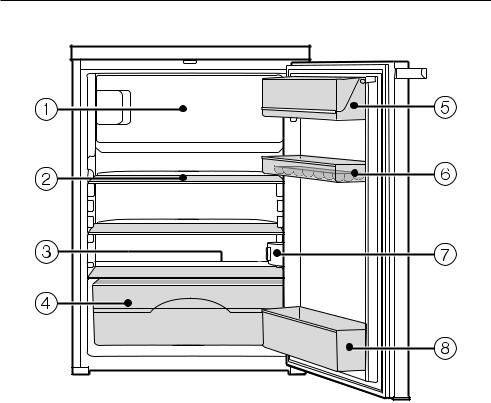
Guide to the appliance
K 12010 S-2, K 12012 S-2 |
Freezer compartment* |
Butter and cheese compartment |
Adjustable shelves |
Door shelf/Egg tray |
(number will depend on model) |
On/Off and temperature selector, |
|
|
Condensate channel and |
interior lighting and |
drain hole |
winter setting switch* |
Fruit and vegetable container |
Bottle shelf |
|
* Depending on model |
5
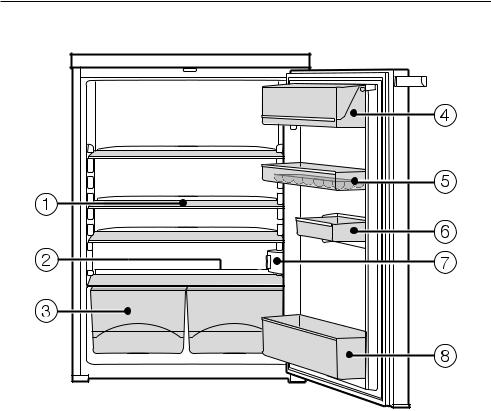
Guide to the appliance
K 12020 S-1, K 12023 S-1 |
Adjustable shelves
(number will depend on model)
Condensate channel and drain hole
Fruit and vegetable containers
Butter and cheese compartment
Door shelf/Egg tray
Half width shelf*
On/Off and temperature selector, interior lighting and
winter setting switch*
Bottle shelf
* Depending on model
6
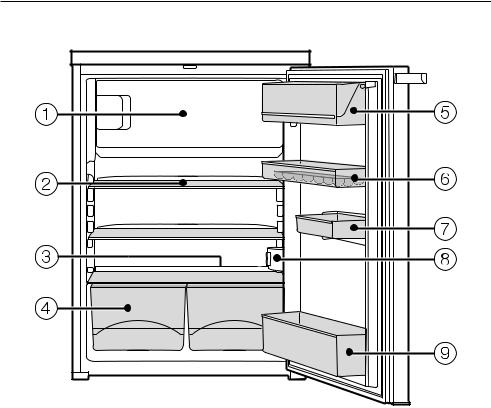
Guide to the appliance
K 12022 S-2, K 12024 S-2 |
Freezer compartment
Adjustable shelves
(number will depend on model)
Condensate channel and drain hole
Fruit and vegetable containers
Butter and cheese compartment
Door shelf/Egg tray
Half width shelf*
On/Off and temperature selector, interior lighting and
winter setting switch
Bottle shelf
* Depending on model
7
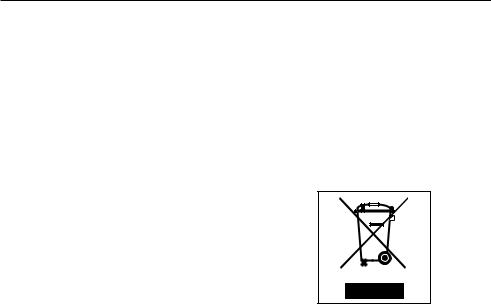
Caring for the environment
Disposal of the packing material
The transport and protective packing has been selected from materials which are environmentally friendly for disposal, and should be recycled.
Ensure that any plastic wrappings, bags etc. are disposed of safely and kept out of the reach of babies and young children. Danger of suffocation!
Disposal of your old appliance
Electrical and electronic appliances often contain materials which, if handled or disposed of incorrectly, could be potentially hazardous to human health and to the environment. They are, however, essential for the correct functioning of your appliance. Please do not therefore dispose of it with your household waste.
Please dispose of it at your local community waste collection / recycling centre or contact your dealer for advice. Ensure that it presents no danger to children while being stored for disposal.
Take care not to damage the pipework at the back of it before or during transportation to an authorised collection depot.
In this way, refrigerant in the pipework and oil in the compressor will be contained, and will not leak out into the environment.
8

Warning and Safety instructions
This appliance complies with all relevant safety requirements. Inappropriate use can, however, lead to personal injury and damage to property.
To avoid the risk of accidents and damage to the appliance, please read these instructions carefully before installation and before using it for the first time. They contain important information on its safety, installation, use and maintenance. Miele cannot be held liable for damage caused by non-compliance with these Warning and Safety instructions.
Keep these instructions in a safe place and ensure that new users are familiar with the content. Pass them on to any future owner.
Correct application
The appliance is not designed for commercial use. It is intended for use in domestic households and similar working and residential environments.
This appliance is not intended for outdoor use.
This appliance is intended for domestic use only for the cool storage of food and drink as well as for storing deep frozen food, freezing fresh food and for preparing ice.
Any other usage is not supported by the manufacturer and could be dangerous.
The appliance is not suitable for storing and keeping cool medicines, blood plasma, laboratory preparations or other such materials or products. Incorrect use of the appliance for such purposes can cause deterioration of the items stored The appliance is not suitable for use in areas where there is a risk of explosion. Miele cannot be held liable for damage resulting from incorrect or improper use or operation.
9

Warning and Safety instructions
The appliance can only be used by people with reduced physical, sensory or mental capabilities, or lack of experience and knowledge, if they are supervised whilst using it, or have been shown how to use it in a safe way and understand the hazards involved.
Safety with children
Children under 8 years of age must be kept away from the appliance unless they are constantly supervised.
Children 8 years and older may use the appliance only if they have been shown how to use it in a safe way and understand the hazards involved.
Children must not be allowed to clean or maintain the appliance unsupervised.
This appliance is not a toy! To prevent the risk of injury, do not allow children to play with it or use the controls. Please supervise children whilst you are using the appliance.
Danger of suffocation. Packaging, e.g. cling film, polystyrene and plastic wrappings, must be kept out of the reach of babies and children. Dispose of or recycle all packaging safely as soon as possible.
Technical safety
Before setting up the appliance, check it for any externally visible damage. Do not install and use a damaged appliance.
It could be dangerous.
If the connection cable is faulty it must only be replaced by a service technician authorised by the manufacturer to protect the user from danger.
10

Warning and Safety instructions
This appliance contains the coolant Isobutane (R600a), a natural gas which is environmentally friendly. Although it is flammable, it does not damage the ozone layer and does not increase the greenhouse effect. The use of this coolant has, however, led to a slight increase in the noise level of the appliance. In addition to the noise of the compressor, you might be able to hear the coolant flowing around the system. This is unavoidable, and does not have any adverse effect on the performance of the appliance.
Care must be taken during the transportation and installation of the appliance that no parts of the cooling system are damaged. Leaking coolant can damage the eyes.
In the event of any damage:
- avoid open flames and anything which creates a spark, - disconnect from the mains,
- air the room in which the appliance is located for several minutes and
- contact the Service Department for advice.
The more coolant there is in an appliance, the larger the room it should be installed in. In the event of a leakage, if the appliance is in a small room, there is the danger of combustible gases building up. For every 8 g of coolant at least 1 m3 of room space is required. The amount of coolant in the appliance is stated on the data plate inside the appliance.
Safe operation of the appliance is only assured if it has been installed and connected in accordance with these operating and installation instructions.
Before connecting the appliance, make sure that the connection data on the data plate (voltage and frequency) matches the mains electricity supply.
This data must correspond in order to avoid the risk of damage to the appliance. Consult a qualified electrician if in any doubt.
11

Warning and Safety instructions
Do not connect the appliance to the mains electricity supply by a multi-socket adapter or an extension lead. These do not guarantee the required safety of the appliance (e.g. danger of overheating).
The electrical safety of this appliance can only be guaranteed when it is correctly earthed. It is most important that this basic safety requirement is observed and regularly tested and where there is any doubt the household wiring system should be inspected by a qualified electrician.
The manufacturer cannot be held liable for the consequences of an inadequate earthing system (e.g. electric shock).
Installation, maintenance and repairs may only be carried out by a suitably qualified and competent person in strict accordance with current national and local safety regulations.
Repairs and other work by unqualified persons could be dangerous. The manufacturer cannot be held liable for unauthorised work.
While the appliance is under guarantee, repairs should only be undertaken by a service technician authorised by the manufacturer. Otherwise the guarantee will be invalidated.
The appliance must be isolated from the electricity supply during installation, maintenance and repair work.
Faulty components must only be replaced by genuine Miele original spare parts. The manufacturer can only guarantee the safety of the appliance when Miele replacement parts are used.
This appliance must not be used in a non-stationary location (e.g. on a ship).
In areas which may be subject to infestation by cockroaches or other vermin, pay particular attention to keeping the appliance and its surroundings in a clean condition at all times. Any damage which may be caused by cockroaches or other vermin will not be covered by the guarantee.
12

Warning and Safety instructions
Correct use
The appliance is designed for use within certain climate ranges (ambient temperatures), and should not be used outside this range. The climate range for your appliance is stated on the data plate inside the appliance.
Installing it in a room with too low an ambient temperature, e.g. a garage, can lead to the appliance switching off for longer periods so that it cannot maintain the required temperature.
Do not block the ventilation gaps in the appliance as this would impair the efficiency of the appliance, increase the electricity consumption and could cause damage to the appliance.
The lid on the appliance has a plastic edge. Keep oil and fat spills away from this as they could cause the plastic to crack and split.
Never handle frozen food with wet hands. Your hands may freeze to the frozen food. Danger of frost burn.
Do not take ice cubes out with your bare hands and never place ice cubes or ice lollies in your mouth straight from the freezer.
The very low temperature of the frozen ice or lollies can cause frost burn to the lips and tongue.
Do not refreeze thawed or partially thawed food.
Defrosted food should be used up as quickly as possible, as food soon loses its nutritional value and goes off. Defrosted food may only be re-frozen after it has been cooked.
Do not store cans or bottles containing carbonated drinks or liquids which could freeze in the freezer. The cans or bottles could explode.
Danger of injury and damage to the appliance.
13

Warning and Safety instructions
When cooling drinks quickly in the freezer, make sure bottles are not left in for more than one hour, otherwise they could burst, resulting in injury or damage.
Observe the "use-by" dates given on food to avoid the risk of food poisoning.
Storage times will depend on several factors, including the freshness and quality of the food as well as the temperature at which it is stored. Follow the instructions given on food manufacturer's packaging on storage conditions required, as well as the "use by" date.
Do not store explosive materials in the appliance or any products containing propellants (e.g. spray cans). Thermostats switching on may produce sparks which could present a fire hazard. Flammable compounds could explode.
Do not operate any electrical equipment (e.g. an electric
ice-cream maker) inside the appliance. Danger of sparking and explosion.
If storing alcohol with a high percentage proof in the refrigerator, make sure the bottle is tightly closed and stored upright.
Danger of explosion.
If storing food which contains a lot of fat or oil in the refrigerator or refrigerator door, make sure that it does not come into contact with plastic components as this could cause stress cracks.
Do not use sharp edged objects to
–remove frost and ice,
–separate frozen foods or remove ice trays.
They will damage the evaporator, causing irreversible damage to the appliance.
14

Warning and Safety instructions
Never place electric heaters or candles in the appliance to defrost it. These can damage the plastic parts.
Do not use defrosting sprays or de-icers, as they might contain substances which could damage the plastic parts or which could cause a build-up of gases and pose a danger to health.
Do not use a steam-cleaning appliance to defrost or clean this appliance. Steam could reach electrical components and cause a short circuit.
Do not use any oils or grease on the door seal, as these will cause the seal to deteriorate and become porous with time.
Disposal of your old appliance
Before disposing of an old appliance, first make the door latch or lock unusable.
This way you will prevent children from accidentally locking themselves in and endangering their lives.
Be careful not to damage any part of the pipework whilst awaiting disposal, e.g. by
–puncturing the refrigerant channels in the evaporator.
–bending any pipework.
–scratching the surface coating.
Splashes of refrigerant can damage the eyes.
15
